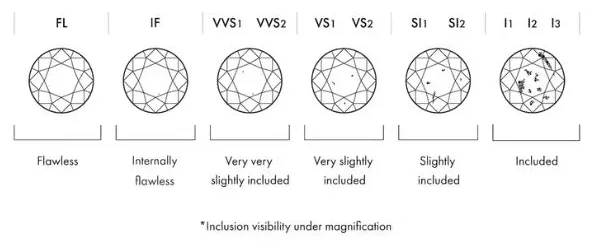Diamond Education: Understanding the 4 Cs
Diamonds have captivated humans for centuries with their unmatched brilliance and elegance. They are often the centerpiece in engagement rings, necklaces, earrings, and many other jewelry pieces. However, not all diamonds are the same, and their value can vary significantly based on specific criteria. This is where the Four C’s developed by the Gemological Institute of America (GIA) come into play. Dive into this primer on diamond quality to help you make an informed purchase.
1. Cut
When talking about the 4 Cs, we are focused on how well a round diamond has been cut from its rough state. This C has the most impact on a diamond's sparkle due to light refraction. GIA's cut grade evaluates the following factors:
Brilliance: Is the reflection of white light from the diamond. A well-cut diamond will have maximum brilliance.
Fire: The scattering of white light into the spectrum colors.
Scintillation: The flashes of light or sparkle seen when the diamond is moved.
Other remaining factors are: weight ratio, durability, polish, and symmetry.
Grading: There are 5 diamond cut grades, ranging from Excellent to Poor. A diamond with an excellent cut will reflect light to its full potential, where a poor cut diamond will look dark.

2. Carat
Carat refers to a diamond's weight. One carat is equivalent to 0.2 grams.
Many believe carat refers to size, but that is not always the case depending on the cut grade. In general, more carats usually does mean a larger diamond.
Price: Larger diamonds are rarer and exponentially more expensive. Two diamonds of the same carat weight can have different costs based on the other C’s.

3. Clarity
Diamond clarity measures the number, size, and position of internal (inclusions) and external (blemishes) imperfections.
Grading Scale: The GIA (Gemological Institute of America) clarity scale includes 11 grades, from Flawless (no inclusions or blemishes visible under 10x magnification) to Included (inclusions and/or blemishes visible to the naked eye).
Buying Tip: Many inclusions are microscopic and don't affect a diamond's beauty. You can often save money without sacrificing visual beauty by choosing a diamond graded as "slightly included."

4. Color
Diamond color actually refers to the lack of color. A perfect diamond has no hue and is valued higher.
Grading Scale: The GIA grades diamonds from D (colorless) to Z (light yellow or brown).

Understanding the Four C’s is crucial in making an informed diamond purchase. Each diamond is unique, like a fingerprint. It's a combination of these four factors that determine its quality, beauty, and value. When making your next purchase at Jae's Jewelers, ensure you prioritize which of the Four C’s matter most to you and balance them with your budget.
Remember, while the Four C’s offer a technical perspective on the diamond's quality, the emotional and symbolic value of a diamond piece is priceless. Always choose what speaks to your heart and resonates with your personal story. Contact us today at 305-443-7724 to schedule your free diamond consultation.
1. Cut
When talking about the 4 Cs, we are focused on how well a round diamond has been cut from its rough state. This C has the most impact on a diamond's sparkle due to light refraction. GIA's cut grade evaluates the following factors:
Brilliance: Is the reflection of white light from the diamond. A well-cut diamond will have maximum brilliance.
Fire: The scattering of white light into the spectrum colors.
Scintillation: The flashes of light or sparkle seen when the diamond is moved.
Other remaining factors are: weight ratio, durability, polish, and symmetry.
Grading: There are 5 diamond cut grades, ranging from Excellent to Poor. A diamond with an excellent cut will reflect light to its full potential, where a poor cut diamond will look dark.

2. Carat
Carat refers to a diamond's weight. One carat is equivalent to 0.2 grams.
Many believe carat refers to size, but that is not always the case depending on the cut grade. In general, more carats usually does mean a larger diamond.
Price: Larger diamonds are rarer and exponentially more expensive. Two diamonds of the same carat weight can have different costs based on the other C’s.

3. Clarity
Diamond clarity measures the number, size, and position of internal (inclusions) and external (blemishes) imperfections.
Grading Scale: The GIA (Gemological Institute of America) clarity scale includes 11 grades, from Flawless (no inclusions or blemishes visible under 10x magnification) to Included (inclusions and/or blemishes visible to the naked eye).
Buying Tip: Many inclusions are microscopic and don't affect a diamond's beauty. You can often save money without sacrificing visual beauty by choosing a diamond graded as "slightly included."

4. Color
Diamond color actually refers to the lack of color. A perfect diamond has no hue and is valued higher.
Grading Scale: The GIA grades diamonds from D (colorless) to Z (light yellow or brown).

Understanding the Four C’s is crucial in making an informed diamond purchase. Each diamond is unique, like a fingerprint. It's a combination of these four factors that determine its quality, beauty, and value. When making your next purchase at Jae's Jewelers, ensure you prioritize which of the Four C’s matter most to you and balance them with your budget.
Remember, while the Four C’s offer a technical perspective on the diamond's quality, the emotional and symbolic value of a diamond piece is priceless. Always choose what speaks to your heart and resonates with your personal story. Contact us today at 305-443-7724 to schedule your free diamond consultation.

